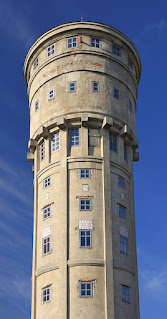Grimsby Dock Tower
Grimsby Dock Tower is a hydraulic accumulator tower and naval landmark at the entrance to the Royal Dock at Grimsby, in north-east Lincolnshire, England. It was completed on March 27, 1852, based on William Armstrong's idea for a hydraulic accumulator to house a Template:Convert/impgal reservoir at a height of 200 feet (61 m), which was used to supply hydraulic power to Grimsby dock equipment. The extreme height of the tower was necessary to achieve sufficient pressure, and as a result the tower can be seen for miles around, even far inland on the north bank of the River Humber in some villages such as Patrington.
 |
| Grimsby Dock Tower / David Wright |
The tower was built to provide water pressure to power hydraulic equipment (cranes, sluice gates and locks) at Grimsby Docks. The tower was built to carry the tank 200 feet (61 m) above ground with a direct feed to the machinery. Small pumps filled the tank while hydraulic mechanisms pumped out the water. The tower system was put into service in 1852 to operate the mechanisms of the sluice gates, dry docks, and fifteen quay cranes, and to supply fresh water to ships and dwellings on the dock area. Water was taken from a well 15 feet (4.6 m) in diameter and 47 feet (14 m) deep, with a 5″ (127,0000000 mm) diameter bore to a chalk cliff in the center, located near where the Grimsby Evening Telegraph office now stands. The well was also fed by seven 5″ (127,0000000 mm) diameter drills at 300 ft (91 m) long intervals, which discharged into the well by a brick culvert 3 ft (0.91 m) in diameter.
The water was conveyed from the well to the tower by a cast iron pipe thirteen inches in diameter, and then forced into the tank by two discharge pumps, each ten inches in diameter, driven by a double horizontal engine of twenty-five inches of horsepower. All the engines, pumps, pipes, and all the machinery were made by Mr. Mitchell of the Perran Foundry in Cornwall. During the construction of the tower Armstrong devised another system using weight accumulators, which at once showed great advantages. The working hydraulic pressure was greater, allowing smaller and cheaper machinery to be used, and everything was at ground level. The first such installation was at the New Holland dock and pier, which were actually put into operation more than a year before the Grimsby system.
The tower was designed by James William Wilde, who based its appearance on the Torre del Mangia tower at Palazzo Pubblico in Siena. It was built under the direction of J. M. Rendell, the civil engineer responsible for the construction of the Royal Dock. The first floor of the tower was decorated with pink, white and blue draperies when Queen Victoria arrived with Prince Albert to visit the dock and "inaugurate" the tower in October 1854. Her Majesty allowed Prince Albert, Prince of Wales, and the Royal Princess to accompany Rendell in a hydraulic elevator to the gallery that wraps around the tower above the water tank, where there is a good view of Grimsby, Cleethorpes and the mouth of the River Humber.
The tower is 309 feet (94 m) high, its width 28 feet (8.5 m) at the base and gradually tapering to 26 feet (7.9 m) below the first ledge; its walls are 4 feet (1.2 m) thick and narrow to 3 feet (0.91 m) at the string course below the cantilevers. The bricks of this simple brick tower were made from clay obtained from excavations in the marsh adjacent to the docks and poured with a mortar of blue lime. The walls make considerable use of ring iron bonding. The tower's foundation is a solid stone wall built on wooden bearing piles. It took about a million bricks to build it. Local legend has it that the tower was built on a foundation of absorbent cotton; the story probably goes back to the fact of West Yorkshire's lucrative cotton imports, which prompted the construction of the Royal Dock and tower
The dock tower continued to supply water to the hydraulic works until 1892, when a hydraulic storage tower was erected on the opposite pier some 200 feet (61 m) northwest of the dock tower took over - the water in this structure was pressurized by a 300-ton load. The existing dock and lock mechanisms are powered by electric or electro-hydraulic power. During World War II, the tower was scheduled for demolition as it served as a beacon for German Luftwaffe planes heading towards Liverpool . A plaque was later placed on the bricks to commemorate the minesweepers of the war. The tower's elevator no longer operates, the upstairs is accessed via a spiral staircase in one corner of the building. The second balcony is currently used for transmitting and receiving radio signals. The tower is Grade I listed and is the subject of a preservation order.



Comments
Post a Comment